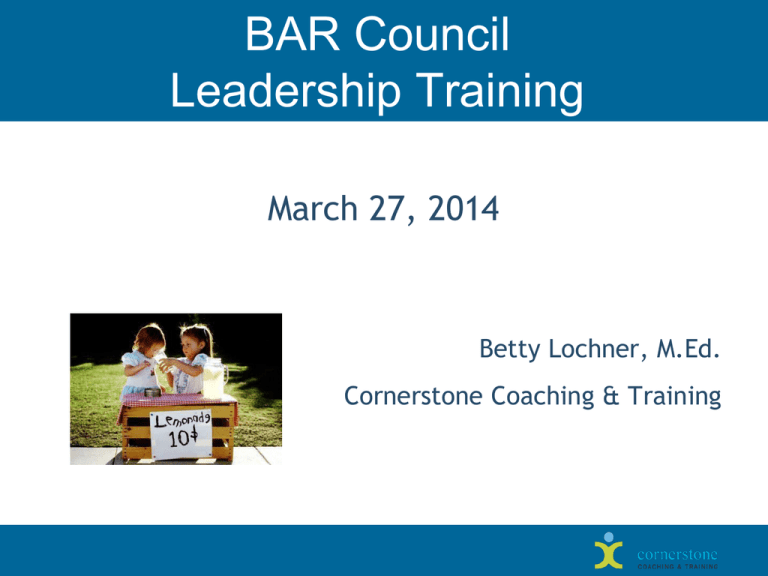BAR Council Leadership Training March 27, 2014 Betty Lochner, M.Ed.
advertisement

BAR Council Leadership Training March 27, 2014 Betty Lochner, M.Ed. Cornerstone Coaching & Training Workshop Agenda We live in a world of possibilities 1. Celebrate What’s Right with the World 2. Performance Coaching for Leaders . . . when we believe it, we’ll see it. Part 1 What can I find that is right about this? Look for the best: • • • In others In yourself In the situation • Connect with a positive vision. • Focus on what is right with the situation. 7 Ways to live a life of gratitude 1. Show gratitude through your words and actions daily. 2. Think positively about your life. 3. Do something you love every single day. 4. Take charge of your own personal development. 5. Pause and reflect. 6. Look at your day differently. 7. Pay it forward. Think of three things that are going right with your world. WRITE THEM DOWN. Man is affected not by his circumstances, but rather the view he takes of them. ~ Victor Frankl, Man’s Search for Meaning Part 2: Performance Coaching for Leaders Why is it when all I want is a pair of hands, and I end up getting the whole person? ~ Henry Ford SUCCESSFUL LEADERS • Solve problems • Motivate • Manage administrative tasks efficiently • Handle interpersonal relationships with skill What is performance coaching? 1. direction, 2. feedback, and 3. encouragement …to enhance Individual and team results 70% of our communication efforts are: •misunderstood •misinterpreted •rejected •distorted •not heard Impact of Feedback on Performance • Informal and frequent positive feedback +39% (increase in performance) • Formal and less frequent positive feedback +37% (increase in performance) • Formal and frequent negative feedback -27% (decrease in performance) • Informal and less frequent negative feedback -11 (decrease in performance) of all Communication is non verbal 55% Tone 38% Visual 7% Verbal Seek First to Understand, then to be Understood. ~ St. Francis of Assisi Where I am now! Situation Choice Point STUCK STATE CYCLE REPEAT: • Behavior • History REACT: • Automatic • Unconscious RESPOND: • Accountable • Conscious Where I am now! Situation Choice Point STUCK STATE CYCLE REPEAT: • Behavior • History REACT: • Automatic • Unconscious GROW PAUSE! PAUSE! Shovel while the piles are small! Be an active listener • Stop talking • Give the speaker your conscious attention • Exercise patience • Be empathetic • Ask clarifying questions • Paraphrase • Make notes Techniques to improve listening skills SUMMARIZE PARAPHRASE Restate what was said in your own words Pull together the main points of a speaker QUESTION Ask open ended questions to clarify both your and their understanding Pay attention to the little things they either build or erode relationships Small things count! Micro-connects Micro-disconnects Small things count! MICRO-DISCONNECTS MICRO-CONNECTS • Avoiding eye contact • Not greeting people • Reading the newspaper while your spouse is talking • Not calling someone by name • Listening actively • Apologizing when appropriate • Acknowledging others • Remembering someone’s birthday • Saying “thank you” Be Tough and Tender Be Tough on Issues & Tender on People There’s always more to the story 10% = Our behavior, statements and positions are visible to all the others. 90% = Invisible aspects: individual or collective backgrounds, attitudes, expectations, dreams, wishes, hurts, fears, needs, feelings, emotions, hidden plans and strategies. THE 3 TRUTHS 1. My “truth” 2. Your “truth” 3. “The” truth THE 4 TRUTH TESTS: 1. Is what I say true? 2. Is how I present it kind and respectful? 3. Is it necessary? 4. Is it timely? 2 ESSENTIAL COMMUNICATION ELEMENTS Safety Courage Build Relationships: Make it Safe • The Problem With too little safety, nothing is discussable. • The Solution With enough safety, you can talk about anything. The “Platinum Rule” …treat others the way they want to be treated! SAFETY: Seeking their truth 1. 2. 3. 4. Pause! Say: “Tell me more!” (“Help me to understand”) Listen with every bone in your body. Find a way to understand: - their facts, - their feelings, and - their perceptions. 5. Reward the feedback! Have Courage to Speak Your Truth GIVE FEEDBACK: SPEAK YOUR TRUTH: • Acknowledge their “Strengths” • I am thinking… • Confront their “Strengths” - Do more of… - Do less of… • I am wanting… • I am feeling… Avoid the assumption trap 1. Don’t make them. 2. Ask for clarification. 3. Make your expectations clear. Make Expectations Clear • This will reduce most, if not all, of your workplace problems! • Here is what I expect: – Here’s what that looks like….. – Do you understand? Can you do that? Develop a Sense of Connection 1. Tell people what you want, not what you don’t want. 2. Change how you see things. STRAIGHT TALK TIPS • Have the courage to tell “your truth” • Make it safe for others to tell “their truth” to you • Seek first to understand – then to be understood • Communicate with clarity • Be authentic & “in service” • Be tough on the issues & tender on people • Speak your truth – sooner • Pay attention to “micro-connects” Work Conversations 1. Workplace Conversations – How to get to dialogue about misunderstandings and disagreements. 2. Workplace Confrontations – How to hold people accountable for meeting expectations. What should I do? • How do you handle a situation with someone who doesn’t report to you, in which you have a concern about their work? How to start a conversation • Is this a good time? • Can we talk? PRESENT MOMENT FEEDBACK Ask: May I give you some feedback? 1. This is what I am experiencing… 2. This is what I am feeling... Shovel while the piles are small! 3. This is what I am wanting… You are rude • How do you deal with someone that is rude to you at work? “I don’t need to listen to you.” Describe the “Gap” 1. We have a problem – and I need your help. 2. Here is what we are expecting… 3. Here is what we are experiencing… 4. We need to close the gap between those two points. Sorry to tell you... • How do you talk to someone about an offensive behavior (e.g. body odor)? Sorry you can’t make it “I heard you scheduled a Team meeting tomorrow. This is the third one you‘ve held while I’m traveling. Are you intentionally trying to cut me out?” What will you say next? Performance Coaching Success Tips – Set expectations – Be clear – Build relationships: make it safe – Plan to communicate: give regular feedback – Have courage: deal with issues sooner rather than later – Expect conflict: practice how to have hard conversations – Know when you need help and where to get it The “Top 10” Job Keepers 1. 2. 3. 4. 5. 6. 7. 8. 9. 10. Career growth, learning & development Exciting work & challenge Making a difference & meaningful work Great people Being part of a team Good boss Recognition for work well done Fun on the job Autonomy, sense of control over my work Flexibility Positive connections Avoid distractions Use open body language Use eye contact Remember names Greet people (look up, smile) Apologize when appropriate Say “please” and “thank you” Celebrate Successes Go to two people in this room and share something that you genuinely appreciate about them. The receiver can only say “thank you”. 12 Ways to Show Appreciation 1. Be kind and respectful. 2. Give regular, positive feedback (be specific) 3. Say “please” and “thank you” 4. Catch someone doing something right. 5. Show genuine interest. 6. Use their name. 7. Give the gift of time. 8. Send a handwritten note or card. 9. One word: food. 10. Create traditions. 11. Celebrate successes. 12. Be of service. Leadership Tips • • • • • • • • Always be positive Be self-aware Be the best employee, boss, you can Model what you want to see Keep things in perspective Check in with staff everyday Have fun Celebrate successes Betty Lochner, M.Ed. www.cornerstone-ct.com MONTHLY NEWSLETTER: Text 22828 FACEBOOK: Cornerstone.ct





